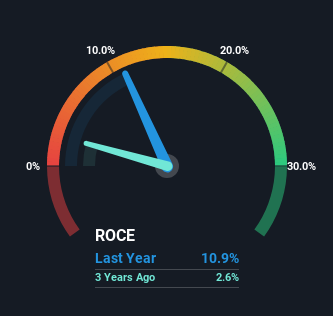- South Korea
- /
- Aerospace & Defense
- /
- KOSE:A047810
Korea Aerospace Industries (KRX:047810) Hasn't Managed To Accelerate Its Returns

What trends should we look for it we want to identify stocks that can multiply in value over the long term? One common approach is to try and find a company with returns on capital employed (ROCE) that are increasing, in conjunction with a growing amount of capital employed. Put simply, these types of businesses are compounding machines, meaning they are continually reinvesting their earnings at ever-higher rates of return. So, when we ran our eye over Korea Aerospace Industries' (KRX:047810) trend of ROCE, we liked what we saw.
Understanding Return On Capital Employed (ROCE)
For those that aren't sure what ROCE is, it measures the amount of pre-tax profits a company can generate from the capital employed in its business. The formula for this calculation on Korea Aerospace Industries is:
Return on Capital Employed = Earnings Before Interest and Tax (EBIT) ÷ (Total Assets - Current Liabilities)
0.11 = ₩342b ÷ (₩7.6t - ₩4.4t) (Based on the trailing twelve months to June 2024).
Thus, Korea Aerospace Industries has an ROCE of 11%. On its own, that's a standard return, however it's much better than the 9.1% generated by the Aerospace & Defense industry.
Check out our latest analysis for Korea Aerospace Industries

In the above chart we have measured Korea Aerospace Industries' prior ROCE against its prior performance, but the future is arguably more important. If you'd like, you can check out the forecasts from the analysts covering Korea Aerospace Industries for free.
So How Is Korea Aerospace Industries' ROCE Trending?
The trend of ROCE doesn't stand out much, but returns on a whole are decent. The company has employed 51% more capital in the last five years, and the returns on that capital have remained stable at 11%. Since 11% is a moderate ROCE though, it's good to see a business can continue to reinvest at these decent rates of return. Stable returns in this ballpark can be unexciting, but if they can be maintained over the long run, they often provide nice rewards to shareholders.
On a side note, Korea Aerospace Industries' current liabilities are still rather high at 59% of total assets. This can bring about some risks because the company is basically operating with a rather large reliance on its suppliers or other sorts of short-term creditors. Ideally we'd like to see this reduce as that would mean fewer obligations bearing risks.
What We Can Learn From Korea Aerospace Industries' ROCE
The main thing to remember is that Korea Aerospace Industries has proven its ability to continually reinvest at respectable rates of return. However, over the last five years, the stock has only delivered a 35% return to shareholders who held over that period. So because of the trends we're seeing, we'd recommend looking further into this stock to see if it has the makings of a multi-bagger.
Korea Aerospace Industries does have some risks though, and we've spotted 1 warning sign for Korea Aerospace Industries that you might be interested in.
While Korea Aerospace Industries may not currently earn the highest returns, we've compiled a list of companies that currently earn more than 25% return on equity. Check out this free list here.
Valuation is complex, but we're here to simplify it.
Discover if Korea Aerospace Industries might be undervalued or overvalued with our detailed analysis, featuring fair value estimates, potential risks, dividends, insider trades, and its financial condition.
Access Free AnalysisHave feedback on this article? Concerned about the content? Get in touch with us directly. Alternatively, email editorial-team (at) simplywallst.com.
This article by Simply Wall St is general in nature. We provide commentary based on historical data and analyst forecasts only using an unbiased methodology and our articles are not intended to be financial advice. It does not constitute a recommendation to buy or sell any stock, and does not take account of your objectives, or your financial situation. We aim to bring you long-term focused analysis driven by fundamental data. Note that our analysis may not factor in the latest price-sensitive company announcements or qualitative material. Simply Wall St has no position in any stocks mentioned.
About KOSE:A047810
Korea Aerospace Industries
Manufactures and sells fixed and rotary wing aircrafts, and airframe products in South Korea.
Excellent balance sheet and good value.
Similar Companies
Market Insights
Community Narratives




